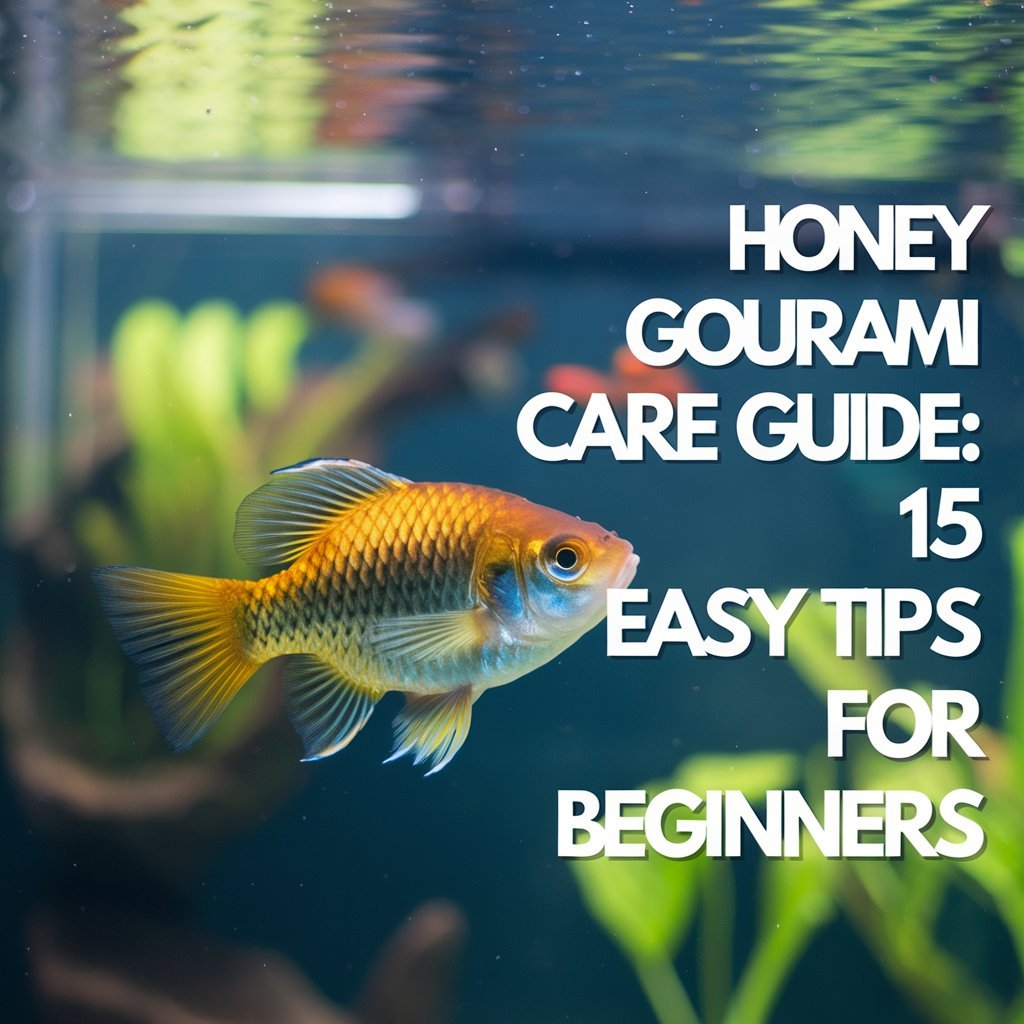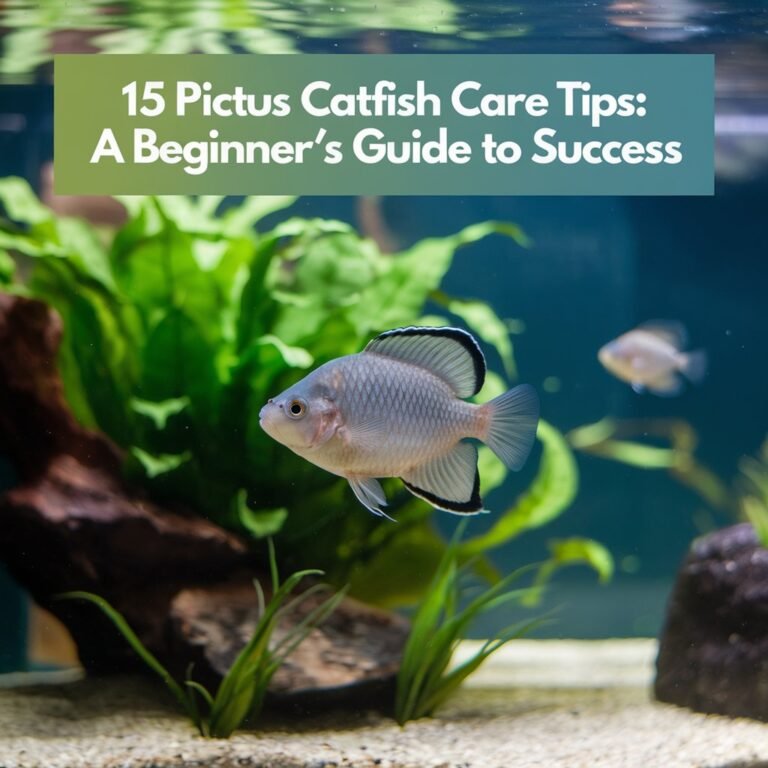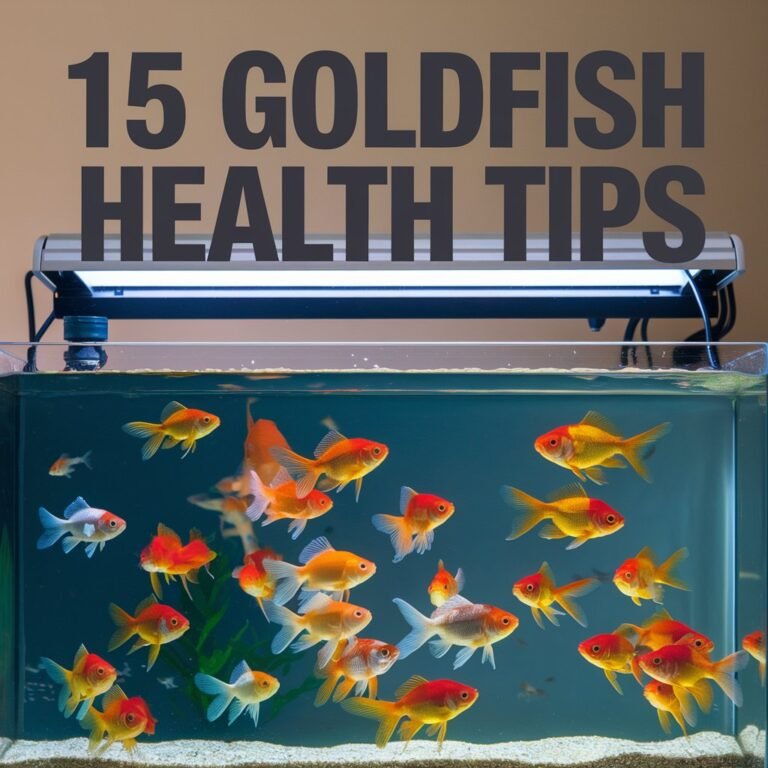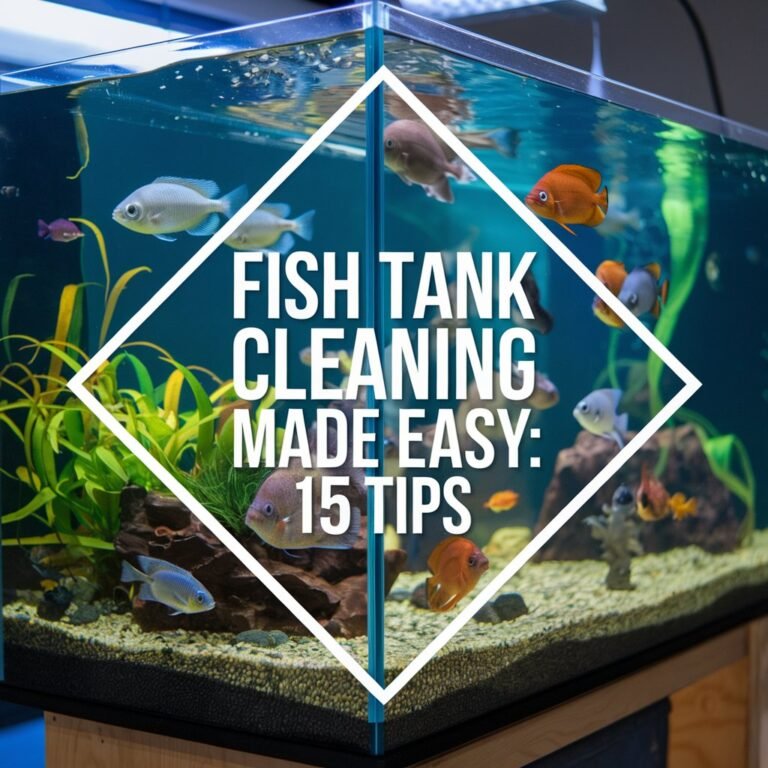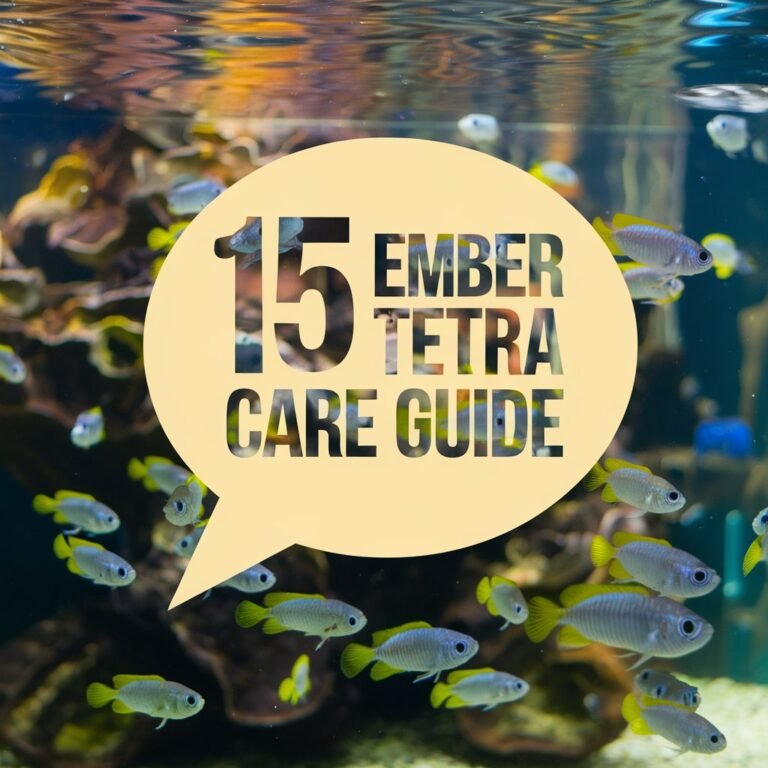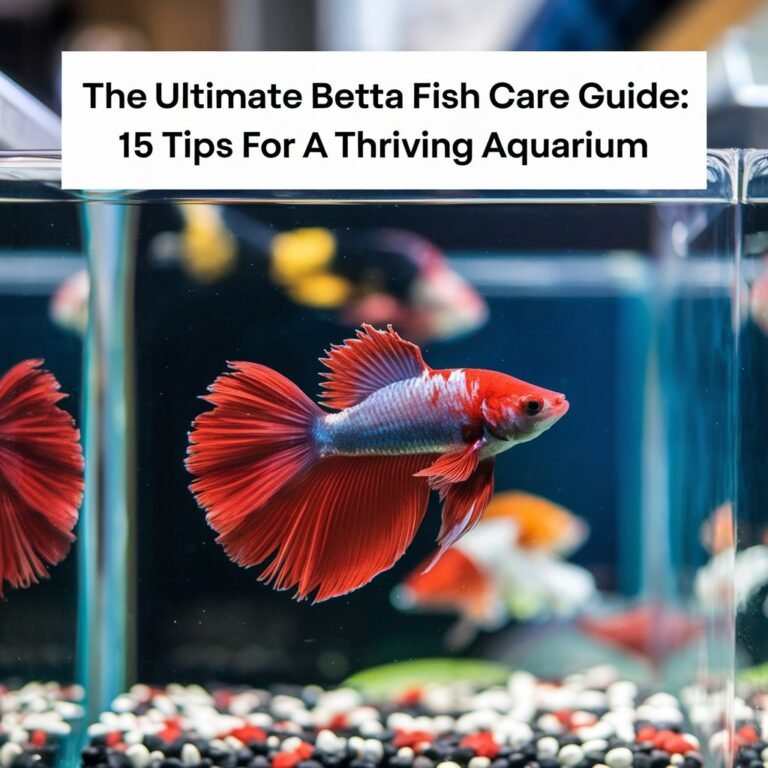Honey Gourami Care Guide: 15 Easy Tips for Beginners
You’ve decided to bring home a Honey Gourami, but do you know what it takes to create a thriving environment for these beautiful fish? Providing the right conditions is vital for their health and happiness.
A spacious tank with plenty of plants and decorations is just the beginning. But without proper water parameters and quality care, your Honey Gourami may not survive.
You’ll need to maintain ideal water temperature, feed a balanced diet, and avoid aggressive tankmates. But what specific steps should you take to guarantee your Honey Gourami flourishes? Let’s take a closer look at the essential care tips you need to know.
In A Nutshell

- Provide a 10-15 gallon tank per Honey Gourami, considering their adult size and territorial nature.
- Incorporate plenty of plants and decorations to replicate their natural habitat and create hiding places.
- Test water parameters regularly and maintain pH levels between 6.8 and 8.0 for optimal water conditions.
- Feed a balanced diet with high-quality commercial flakes or pellets and supplement with live or frozen foods.
- Research compatible tankmates, such as schooling fish and peaceful species, to ensure a harmonious aquarium.
Choosing the Right Tank Size
Choosing the right tank size for your Honey Gourami is essential in creating a harmonious balance between its well-being and your aquarium’s ecosystem.
A general rule of thumb is to provide at least 10 gallons of water per Honey Gourami, given their adult size and territorial nature. However, it’s not just about aquarium size – tank shape also plays a pivotal role.
A longer tank is preferred over a taller one, as it allows for better swimming space and territorial establishment.
When selecting a tank, consider the mature size of your Honey Gourami, which is typically around 2-3 inches.
For a single adult, a 10-15 gallon tank is suitable. However, if you plan to keep a pair or a small group, a 20-30 gallon tank is recommended.
Avoid small tanks, as they can lead to water quality issues and stress your fish.
Remember, a larger tank provides a more stable environment and allows for better water circulation, filtration, and oxygenation.
Setting Up the Perfect Environment
To create an ideal environment for your Honey Gourami, you’ll need to focus on replicating their natural habitat.
In the wild, Honey Gouramis inhabit slow-moving streams and rivers with dense vegetation.
To mimic this environment, you’ll want to incorporate plenty of plants and decorations into your tank.
When it comes to tank decoration, you’ll want to choose items that provide plenty of hiding places and visual barriers for your Honey Gourami.
This can include plants like Java moss, Anacharis, and Amazon swordplants, as well as decorations like rocks, driftwood, and sunken logs.
Aquatic landscaping is also vital, as it helps to create a sense of depth and visual interest in the tank.
Consider creating a layered effect by placing taller plants in the background and shorter ones in the foreground.
Water Conditions and Quality
As you focus on replicating the natural habitat of your Honey Gourami, you must also consider the water conditions and quality that are crucial for their survival.
To guarantee ideal water conditions, you’ll need to test the water parameters regularly using water testing kits. These kits will help you monitor pH levels, ammonia, nitrite, and nitrate concentrations.
For a healthy environment, you should aim for pH levels between 6.8 and 8.0. Ammonia and nitrite levels should be zero, while nitrate levels should be below 20 ppm.
To achieve these parameters, you’ll need to establish a stable biological balance through the cycling process. This process involves introducing beneficial bacteria to the tank, which break down waste products and maintain a healthy environment.
During the cycling process, it’s crucial to monitor water parameters closely and make adjustments as necessary.
This may involve performing partial water changes or adding supplements to maintain ideal water conditions.
By prioritizing water conditions and quality, you’ll create a thriving environment for your Honey Gourami to grow and flourish.
Regular water testing and maintenance will help you identify and address any issues before they become a problem.
Maintaining Optimal Water Temperature
Most Honey Gourami thrive in water temperatures between 72°F and 82°F (22°C and 28°C).
You should maintain a consistent temperature within this range to keep your Honey Gourami healthy. Temperature fluctuations can stress your fish, making them more susceptible to disease.
It’s crucial to monitor the water temperature regularly to prevent sudden changes.
To maintain ideal water temperature, you’ll need a reliable aquarium thermometer.
Digital thermometers are more accurate and easier to read than analog ones. Place the thermometer in a visible location, away from direct sunlight and aquarium equipment that can affect the reading.
Avoid placing the aquarium near heating or cooling vents, fireplaces, or drafty windows.
These can cause sudden temperature fluctuations that can harm your Honey Gourami. If you live in an area with cold winters or hot summers, consider using a temperature controller to regulate the water temperature.
By maintaining a stable water temperature, you can help keep your Honey Gourami happy and healthy.
Regularly check the thermometer to verify the temperature is within the ideal range.
Creating a Balanced Diet
How do you guarantee your Honey Gourami is receiving the nutrients it needs to thrive?
To certify peak Honey nutrition, you must create a balanced diet that caters to their unique needs. Honey Gouramis are omnivores, requiring a mix of protein-rich foods, vegetables, and whole grains.
Incorporating high-quality commercial flakes or pellets specifically formulated for small tropical fish is crucial.
Supplementing their diet with live or frozen foods, such as brine shrimp or bloodworms, provides essential protein and helps stimulate their appetite.
You should also offer a variety of vegetables like zucchini, spinach, or peas, as these provide indispensable fiber and nutrients.
To keep your Honey Gourami’s appetite piqued, vary their diet by rotating foods regularly.
Gourami appetite can be sensitive, so introducing new foods gradually will prevent digestive issues.
Research and consult reputable sources to create a well-rounded diet that addresses the nutritional requirements of your Honey Gourami, as their dietary needs change throughout their life cycle.
Feeding Your Honey Gourami
When introducing food to your Honey Gourami, you’ll need to ponder their feeding behavior and preferences to guarantee they’re eating adequately.
Honey Gourami are opportunistic feeders that primarily consume small invertebrates and algae in the wild. To replicate this in captivity, you’ll want to provide a varied diet consisting of high-quality commercial foods.
Offer your Honey Gourami a staple diet of high-protein pellets, such as honey pellets, 2-3 times a day.
Supplement their diet with live or frozen foods 1-2 times a week. Live brine shrimp is an excellent option, as it provides essential nutrients and stimulates their natural hunting behavior.
Avoid overfeeding, as Honey Gourami are prone to obesity. Feed them only as much as they can consume within 1-2 minutes to prevent food from spoiling and contaminating the water.
Observe your Honey Gourami’s eating habits and adjust their diet accordingly.
Verify that all food is fully consumed before adding more to prevent waste and maintain superior water quality.
Providing Hiding Places and Plants
As a general rule of thumb for aquatic habitat creation, including many layers and complexities provides multiple hiding spots, elevations, and ambiance within an aquatic setup.
For a honey gourami aquarium, consider adding various elements like rocky crevices and overhangs, plants, driftwood, or decorative stones to provide the required shelter. Incorporate tall and wide plants around the edges or rear to break up sightlines, thereby helping reduce territorial behaviors.
When selecting live plants, opt for hardy plant species that are balanced and blend various sizes of leaf forms. Combine water-willow, dwarf sagittaria, or other dense vegetation that offers hiding places, swimming channels, and varied height profiles.
Balance and distribution are crucial as densely-placed live plants limit free space within an aquarium setup and potential development may disbalance spatial coverage according to available substrate size plus reduce choice surrounding.
Selecting Compatible Tankmates
In a well-planned honey gourami aquarium, you’ll want to choose tankmates that complement their peaceful nature.
Honey gouramis are generally calm and non-competitive, so they’ll thrive with tankmates that share similar traits. Schooling fish are an excellent choice, as they’ll provide entertainment and distraction without competing for food or space. Some popular schooling fish that work well with honey gouramis include lemon tetras, harlequin rasboras, and white cloud mountain minnows.
When selecting tankmates, focus on peaceful species that occupy different levels of the tank.
Mid-water swimmers like hatchetfish and corydoras catfish can be added to create a layered effect. Avoid mixing honey gouramis with fin-nipping species, as this can cause stress and damage to their elaborate fins. Also, guarantee that the tankmates you choose are compatible with respect to water parameters and diet.
A well-researched and thoughtfully planned community tank will provide a harmonious environment for your honey gouramis to thrive. By choosing the right tankmates, you’ll create a visually appealing and balanced aquarium that showcases the beauty of your honey gouramis.
Avoiding Aggressive Fish Species
Aggressive fish species can be the downfall of a harmonious honey gourami aquarium.
You must avoid housing your honey gouramis with finicky neighbors that can harass or attack them. Some fish species to avoid include tiger barbs, fin-nipping tetras, and large cichlids.
These aggressive fish can cause stress and injury to your honey gouramis, leading to disease and even death.
When selecting tankmates for your honey gouramis, choose peaceful companions that are calm and non-territorial.
Research compatible fish species that thrive in similar water conditions and have a peaceful temperament. Some good options include harlequin rasboras, lemon tetras, and dwarf neon rainbowfish.
These peaceful fish can coexist with honey gouramis without causing stress or aggression.
To guarantee a harmonious aquarium, introduce new fish slowly and under close observation.
Monitor their behavior and body language, and separate them immediately if you notice any signs of aggression.
Honey Gourami Breeding and Spawning
You’ve created a harmonious environment for your honey gouramis by selecting peaceful tankmates, and now it’s time to focus on their reproductive habits.
Honey gouramis are known to breed in captivity, but they require specific conditions to trigger their breeding instincts. Breeding triggers include a balanced diet rich in protein, ideal water temperature between 78°F and 82°F, and a slightly acidic pH between 6.5 and 7.5.
To induce spawning, you can simulate the rainy season by increasing the water level and adding plants with broad leaves.
This will create a sense of security and encourage the male to build a nest. Spawning cycles typically occur in the morning, and the female will release her eggs into the nest.
The male will then fertilize the eggs and guard the nest until the eggs hatch.
Crucial to provide a separate breeding tank with plenty of hiding places and plants to reduce stress and increase the chances of successful spawning.
Common Health Issues and Symptoms
Certain health issues can affect honey gouramis, and being aware of these conditions can help you provide proper care and prevent illness.
Fin rot, a common bacterial infection, can cause frayed or torn fins, and may lead to secondary infections if left untreated. You’ll notice your honey gourami’s fins becoming discolored, frayed, or developing white or black edges.
Fungal infections are another common issue in honey gouramis. These infections can cause white, cotton-like growths on the fish’s body, fins, or gills.
You may also notice labored breathing, lethargy, or loss of appetite in infected fish. Fungal infections can be caused by poor water quality, stress, or injury.
Regular water changes, proper filtration, and a balanced diet can help prevent these health issues.
You should also monitor your honey gourami’s behavior and appearance regularly, looking for signs of illness or stress.
By being aware of these common health issues, you can take steps to prevent them and guarantee your honey gourami stays healthy and thriving.
Regular monitoring and maintenance can go a long way in preventing illness and promoting overall health in your honey gourami.
Recognizing and Treating Diseases
When recognizing and treating diseases in honey gouramis, it’s vital that you act quickly and effectively to prevent the spread of infection and minimize harm to your fish.
Regular monitoring of your honey gouramis’ behavior and appearance can help you identify early warning signs of disease.
Fungal infections are common in honey gouramis, particularly in those that are injured or stressed. You’ll notice visible growths or cotton-like tufts on the skin, fins, or gills.
Bacterial outbreaks, on the other hand, can cause symptoms such as labored breathing, lethargy, and loss of appetite. You may also notice red streaks or spots on the skin, which can indicate a bacterial infection.
To treat fungal infections, use an antifungal medication specifically designed for aquarium use. For bacterial outbreaks, administer a broad-spectrum antibiotic according to the manufacturer’s instructions.
Always quarantine the affected fish to prevent the spread of infection and make sure to follow proper dosing instructions to avoid further stressing the fish. Regularly test the water for any changes in water chemistry, as this can also impact the effectiveness of the treatment.
Performing Regular Water Changes
Regular water changes are crucial in maintaining ideal water quality for your honey gouramis.
You should aim to replace 10-15% of the tank’s water every week. This frequency helps prevent the buildup of toxins and maintains stable water parameters.
When performing water changes, turn off your aquarium’s equipment and remove any decorations or plants that may get in the way.
Use a gravel vacuum to remove debris and waste from the substrate. Then, siphon out the old water and discard it. Replace the old water with fresh, dechlorinated water that matches the tank’s temperature.
As part of your aquarium maintenance routine, you should also test the water regularly to confirm it’s safe for your honey gouramis.
You should test the water at least once a week, but more frequently if you notice any changes in your fish’s behavior or water quality.
Monitoring Water Parameters and Tests
Monitoring water parameters is essential in ensuring the health and well-being of your honey gouramis.
You’ll need to regularly test the water for various parameters, including pH, ammonia, nitrite, and nitrate levels. Invest in a reliable water testing kit that can provide accurate readings. These kits usually include test strips or liquid test solutions that you’ll use to collect water samples from your aquarium.
When testing the water, make sure to follow the manufacturer’s instructions carefully.
Record the results in your aquarium logs, which will help you track any changes or trends in the water parameters over time. This information will be pivotal in identifying potential issues and making adjustments to maintain ideal water conditions for your honey gouramis.
Regular water testing will also help you detect any sudden changes in the water parameters, which can be life-threatening to your fish.
Creating a Stress-Free Aquarium Environment
You’ll often find that a stress-free aquarium environment is essential for the health, happiness, and well-being of your honey gouramis.
To create this environment, you’ll need to focus on aquarium decoration and layout.
Provide plenty of hiding places and visual barriers by adding plants, rocks, and driftwood. These decorations will help reduce stress and aggression in your honey gouramis.
Consider adding plants with broad leaves, such as Java ferns or Amazon swords, which can provide shelter and reduce stress.
Another way to create a stress-free environment is by adding calming sounds to your aquarium.
You can do this by adding a bubble wall or a powerhead to create gentle water circulation.
The sound of gently moving water can be calming for your honey gouramis.
You can also add a sound system that plays calming sounds, such as gentle waterfalls or ocean waves.
Avoid placing your aquarium near loud speakers or noisy areas, as this can cause stress to your honey gouramis.
Frequently Asked Questions
Can I Keep Honey Gourami in a Community Aquarium With Other Species?
You can keep honey gourami in a community aquarium if you choose compatible tank mates, as they may exhibit aggressive behavior. Research peaceful, small schooling fish that won’t trigger their territorial instincts for a harmonious coexistence.
Are Honey Gouramis Nocturnal or Diurnal Fish?
You observe that honey gouramis, like most fish, have a natural circadian rhythm influenced by light sensitivity. As diurnal fish, they’re typically active during daylight hours and rest at night, following the natural day-night cycle.
How Often Should I Replace My Honey Gourami’s Tank Decorations?
You should replace your honey gourami’s tank decorations every 1-3 months to maintain a tank refresh and stimulate their environment. Implement a decoration rotation to prevent boredom and stress in your fish.
Can I Keep a Single Honey Gourami or Do I Need Multiple?
You can keep a single honey gourami, but be aware that solitary confinement may stress them. Typically, gouramis thrive in pairs or small groups, promoting Gourami harmony, so consider housing multiple if your tank is large enough.
How Long Does a Honey Gourami’s Lifespan Typically Last in Captivity?
You can expect a honey gourami’s lifespan to last 4-8 years in captivity, depending on the aquatic environment and water quality you provide, with proper care and conditions substantially impacting their longevity.
FInal Verdict
You’ve learned the essential tips for keeping your Honey Gourami healthy and thriving. By choosing the right tank size, setting up a suitable environment, and maintaining ideal water conditions, you’re well on your way to creating a stress-free aquarium.
Regular monitoring and testing will help prevent diseases, and a balanced diet will keep your fish happy. Remember to perform regular water changes and avoid aggressive tankmates to guarantee a long, healthy life for your Honey Gourami.
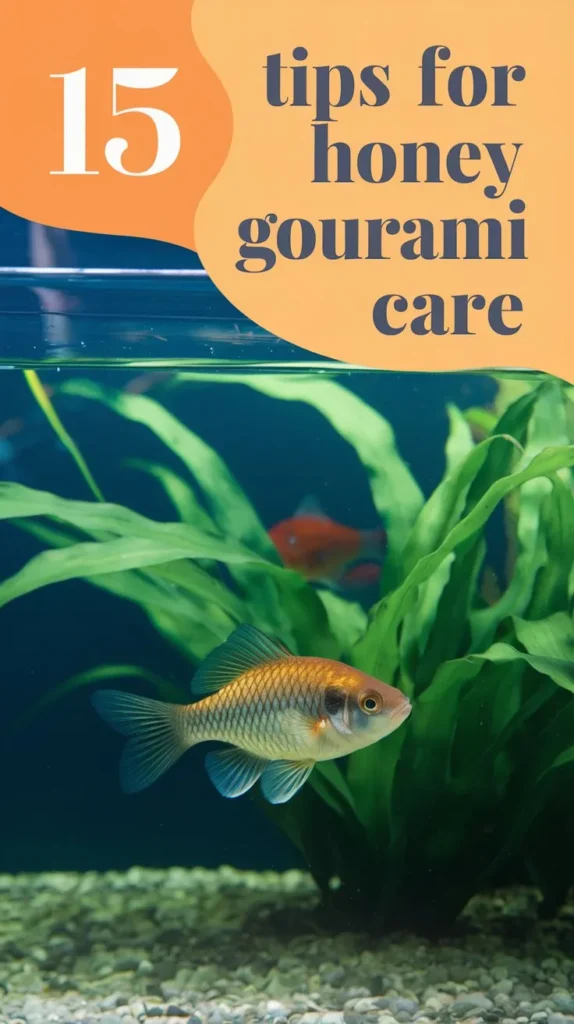
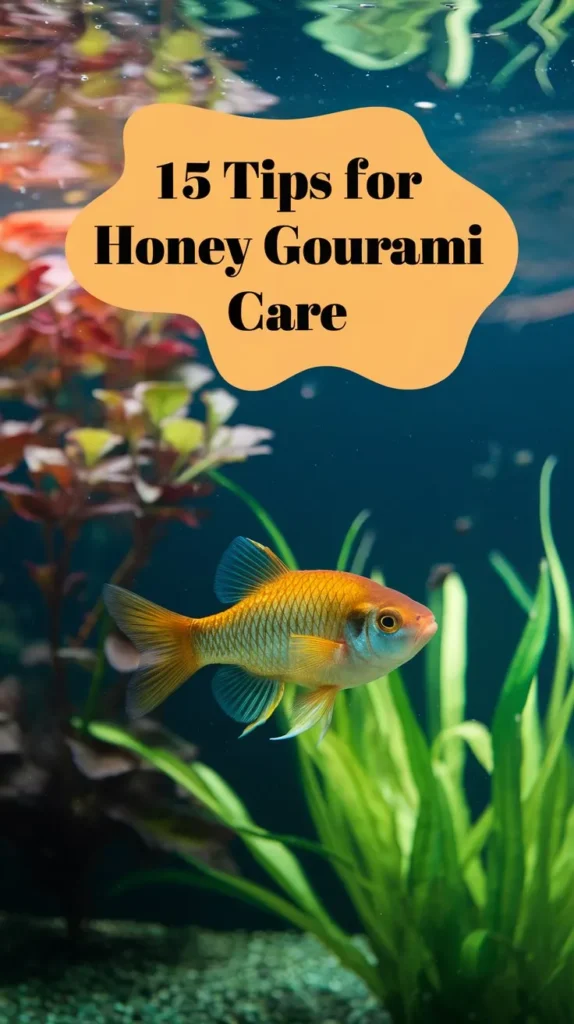
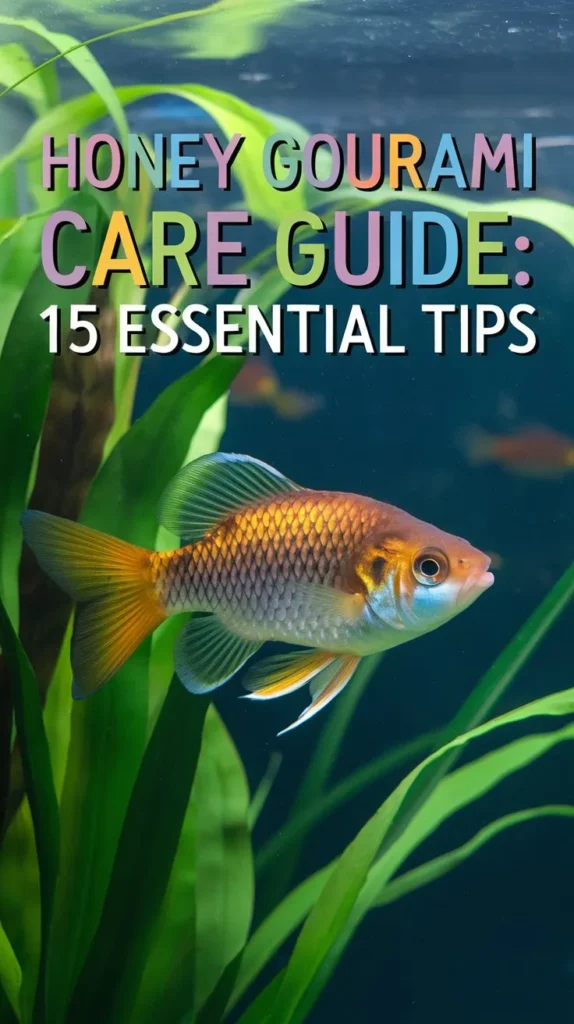
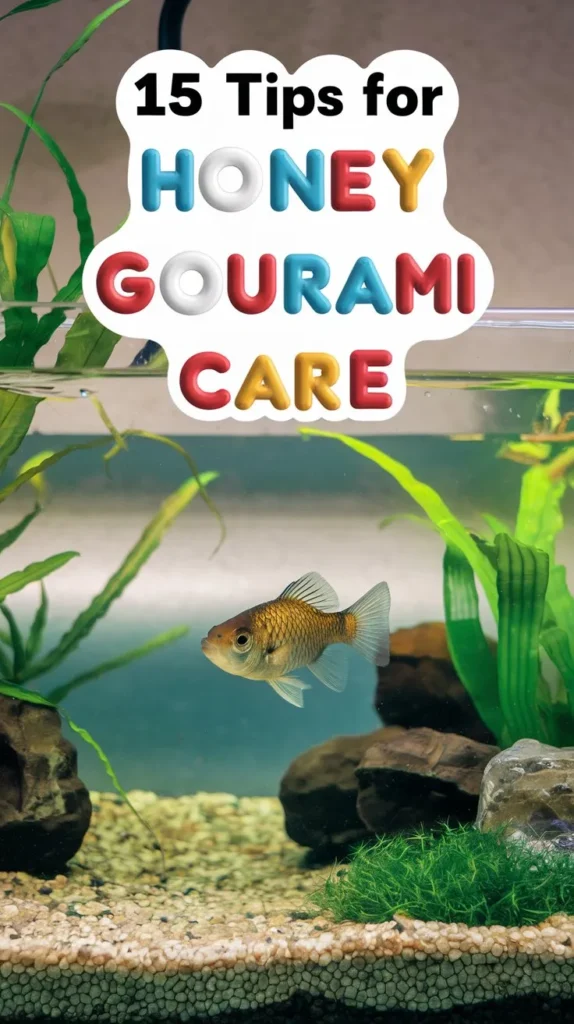

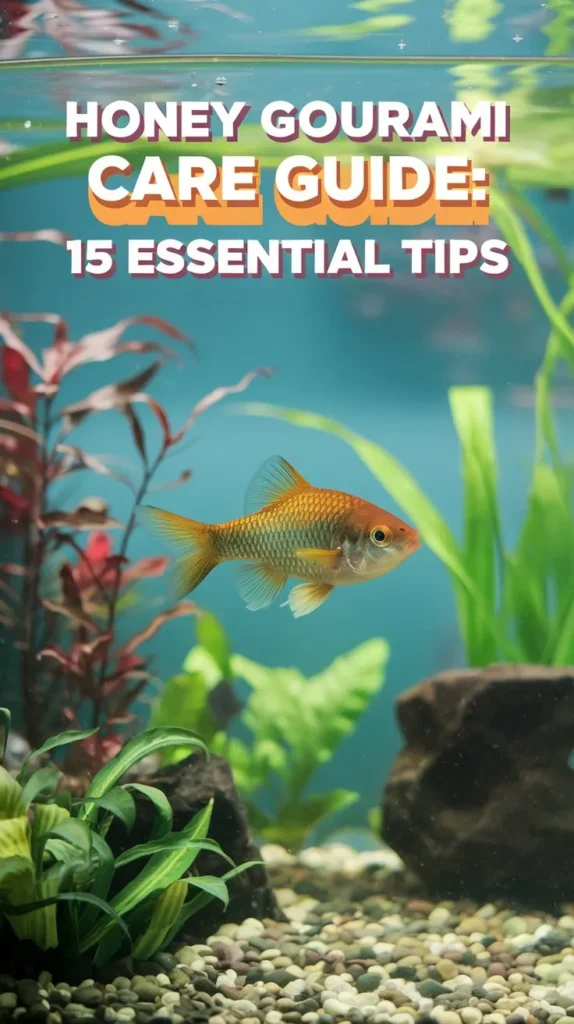
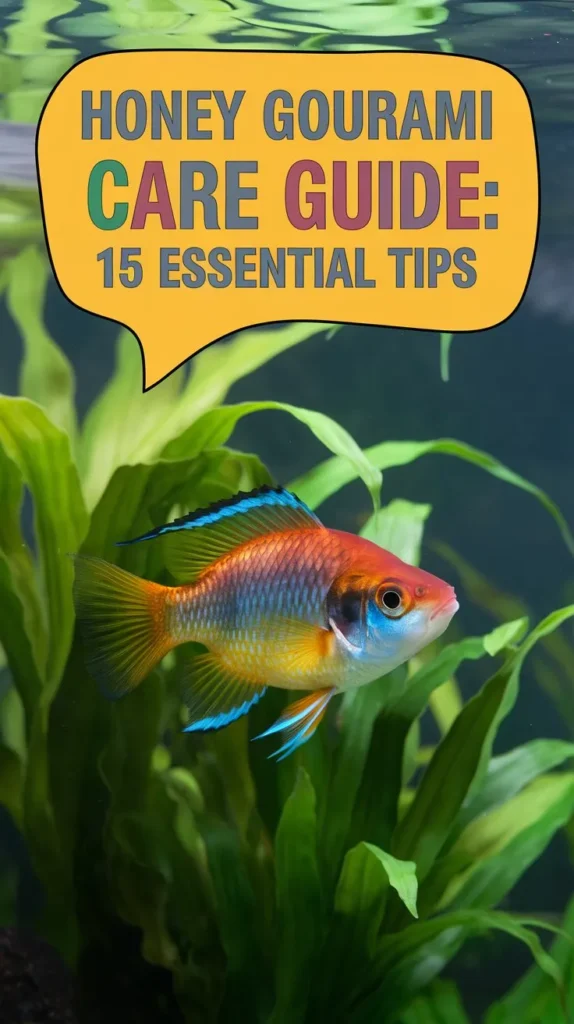
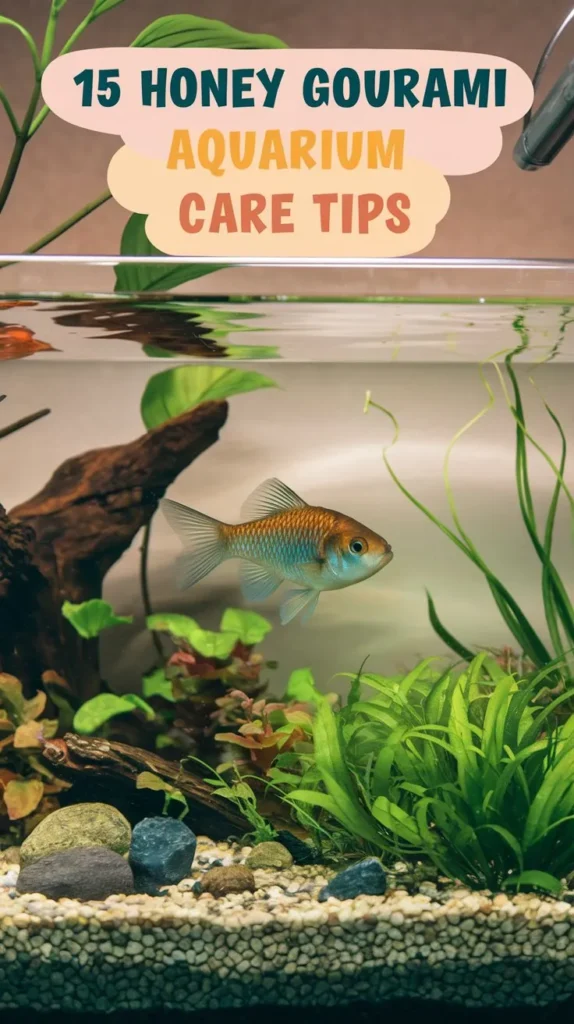


Hello, I’m Aria Cooper, the heart and soul behind Swimmy Buddies. As a devoted fish aficionado, I share my aquatic adventures and expertise to inspire your own underwater explorations. 🐠🌊

